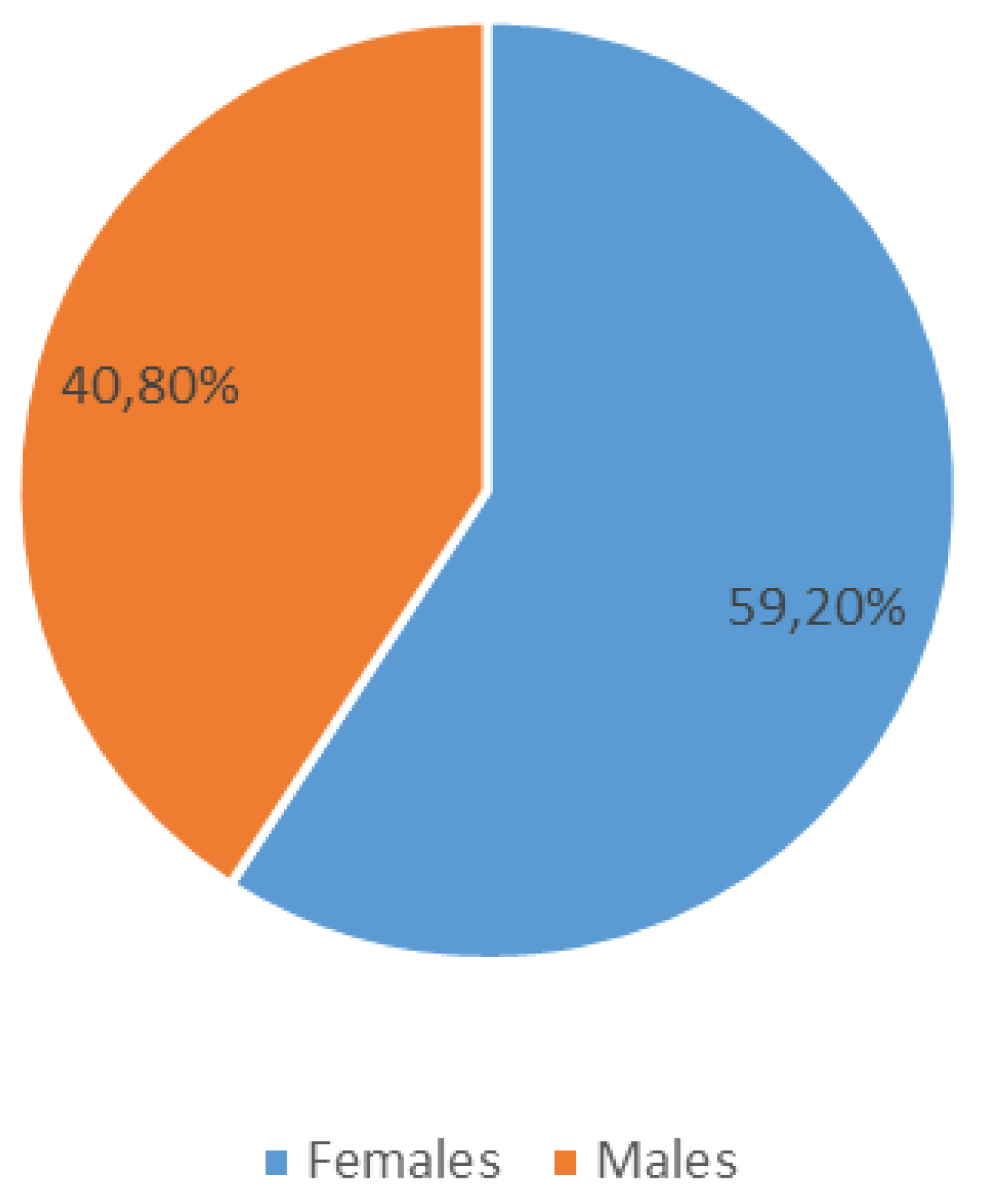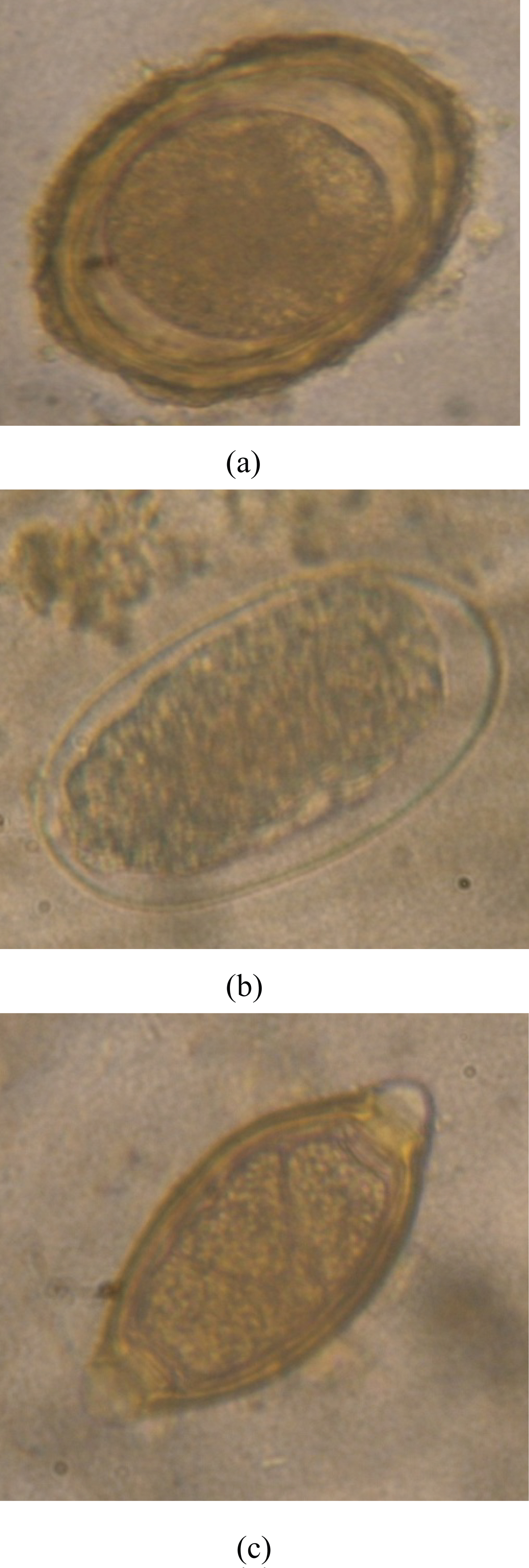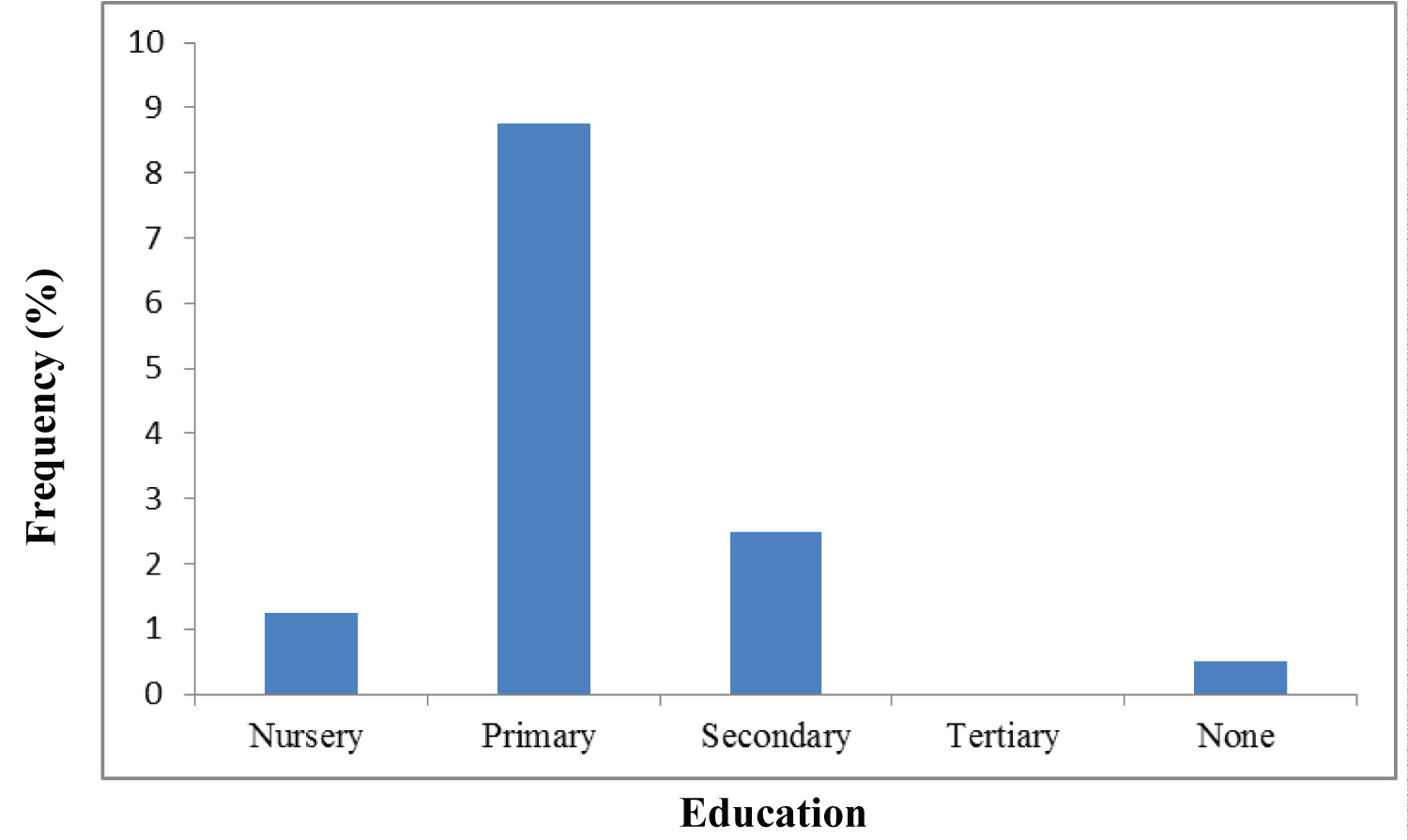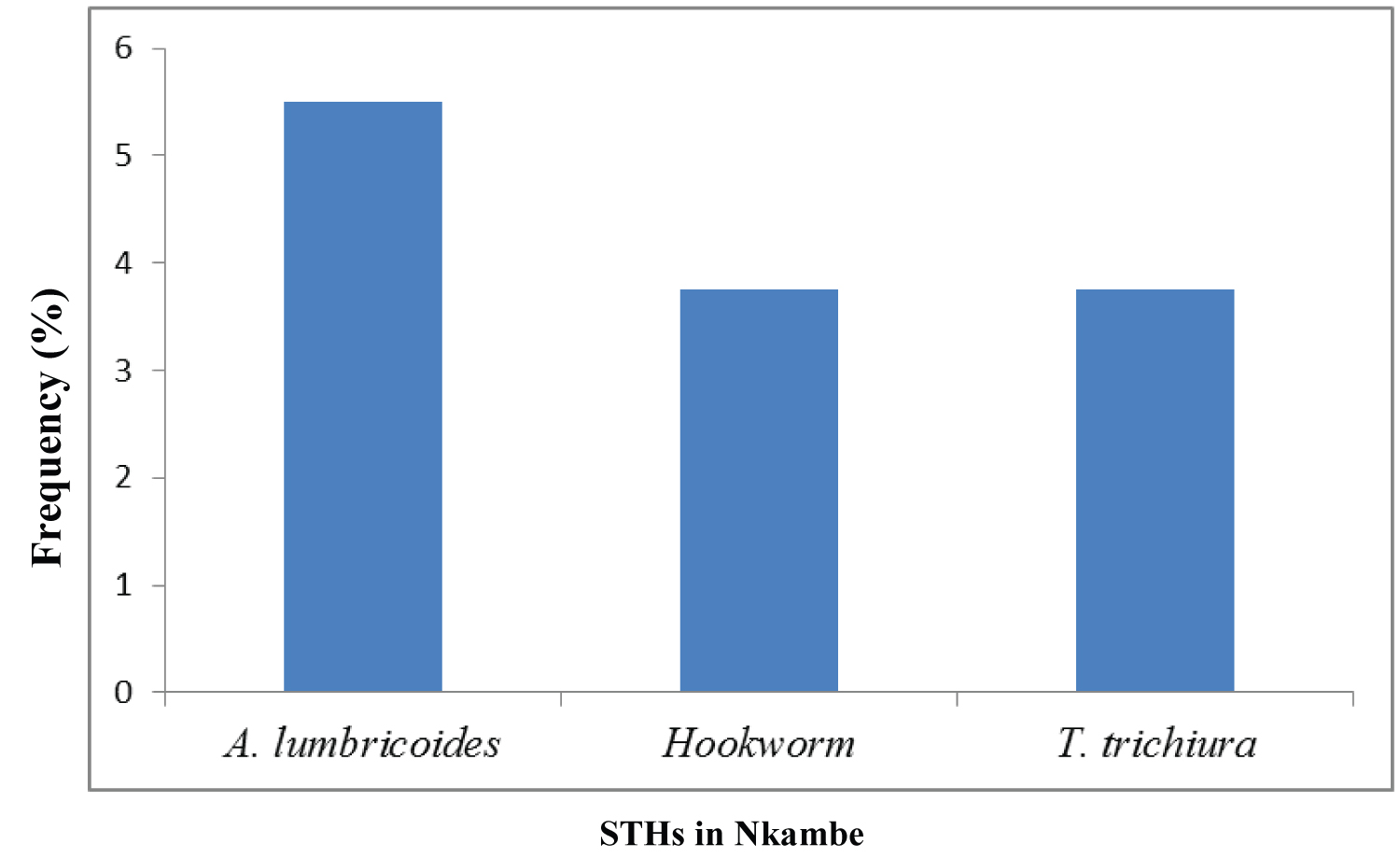Parasitic infections are major health problems worldwide. These parasitic infections are caused by Helminths and Protozoans. High prevalence is mostly in people with low socio-economic status and this is due to lack of hygiene and sanitation. This study aimed at providing systemic data that will be used to determine the prevalence, intensity and the efficacy of anthelminthic drugs (Albendazole 400 mg and Mebendazole 500 mg) against gastrointestinal helminths among the population of Nkambe.
Qualitative and quantitative analysis were carried out by Floatation and McMaster count techniques respectively, while the Chi Square Test was used to analyse demographic parameters, Kruskal Wallis test was used to determine the intensities at 0.05 significant level.
Four hundred (400) stool samples were collected and fifty-two 52(13%) of these samples were infected with at least one nematode species. The intestinal nematodes encountered in this study were: Ascaris lumbricoides, Hookworms and Trichiuris trichiura with the respective prevalences and intensities of infection of (5.5%) and 671.43 ± 317.27), (3.75% and (1000.00 ± 228.03), (3.75) and (478.57 ± 237.68). From our data analysis, the males (7.25%) were infected more than the females (5.75%). Participants between 2-10 and 11-20 years were more infected than adults with 6.75% and 3.5% respective. Faecal egg concentration was 44.2% and these infections were light and moderate. The cure rate for Albendazole (ALB) against A. lumbricoides was 100%, 66.67% for Hookworms and 57% T. trichuira. Mebendazole (MEB) curing rate for Hookworm was 100%, A. lumbricoides 83.4% and was unsatisfactory against T. trichuira. The ERR for ALB 400 mg was 100% for A. lumbricoides, 55% for Hookworms and 44.27% for T. trichuira. (MEB) 500 mg Egg Reduction Rate (ERR) was 100% for Hookworms, 62.9% for A. lumbricoides and T. trichuira had 44.4%.
A single dose of ALB 500 mg is recommended for the treatment of A. lumbricoides, Hookworms and T. trichuira.
Helminths, Albendazole, Mebendazole, Efficacy, Prevalence, Intensity, Nkambe
ALB: Albendazole; CR: Cure Rate; EPG: Egg per gram of faeces; ERR: Egg Reduction Rate; MEB: Mebendazole; NTDs: Neglected Tropical Disease; RHB: Regional Hospital Review Board; SPSS: Statistical Package for Social Science; STHs: Soil Transmitted Helminths
Helminthiasis being a global health burden and is attributed as one of the Neglected Tropical Diseases (NTDs) by medical and international community results to ill-health [1]. They are the major health problems in the tropical and subtropical parts of the world where temperature, humidity, lack of hygiene, poverty, sociocultural habits and demographic factors favor their development [2]. They are responsible for considerable morbidity and in severe cases, cause mortality [3]. Previous studies indicate that the Neglected Tropical Diseases (NTDs) are widespread among the poor in the Sub Saharan Africa (SSA) [4]. These parasites dwell in the gastrointestinal tract in humans and other animals. The World Health Organization (WHO) estimates that over 2 billion individuals suffer from parasitic infections worldwide, resulting to more than 155,000 thousand deaths per year with 97% of these deaths occurring in the developed parts of the world [5]. Soil-transmitted helminths (STHs) is a group of nematode worms causing human infections through contact with parasite eggs or larvae that thrive in the warm and moist soil of the world's tropical and subtropical countries including Cameroon. Soil Transmitted Helminths are the most occurring with an estimated 50% of the world's population, the epidemiology of intestinal parasitic infections shows that these parasites are found in every age group and in both sexes. These infections are higher in Children and the elderly than in middle-aged individuals and between immigrants and refugees [6]. Ascaris lumbricoides a cosmopolitan nematode affects over 1.5 billion people, followed by Ankylostoma 1 billion and T. trichiura 800 million people throughout the world [7]. These intestinal infections caused severe intestinal disorder such as dysentery; diarrhoea, mild abdominal pain, vomiting, and lack of appetite and in some cases lead to mental retardation in children and even affect physical growth and development [8]. In Cameroon, a report from the Cameroonian Public Health Secretary of State revealed that 16.1 million inhabitants with more than 10 million suffer from helminthiasis. The prevalence and intensity of these infections fluctuates from one region to the other [9]. Since 2001, STHs endemic countries have been urged during the 54th World Health Organization [10] assembly to implement periodic and regular deworming of at least once or twice every year among school-aged children and other groups at risk of morbidity in order to eliminate morbidity of STHs in children by 2020 through school-based deworming. The Benzimidazole group usually a single oral dose of Albendazole (400 mg) or Mebendazole (500 mg) is the most widely distributed among the population. Cameroon adopted the strategic plan for the control of schistosomiasis and STHs in 2004, however the nationwide school-based deworming is still in progress [11]. From this report, the prevalence and intensity of gastrointestinal parasites in Cameroon is high and the control programs against these infections among school-aged children is effective in some regions than others, while in other regions, divisions and sub-divisions, prevalence, intensity and the efficacy of anthelminthic drugs against these infections are not really known. Soil-transmitted helminth infections are usually asymptomatic and the manifestations of these infections are not fatal, contrary to the protozoan's infections which is symptomatic and fatal [6]. This might be the reason why STHs has not received proper attention in research findings and public recognition. Some related effects of STHs is that; they reduced the functioning system of the body, Physical performance is reduced and poor cognitivity in children resulting to a decrease in human financial capital among adults of the infected population [2]. This study aimed at providing systemic data that will be used to determine the prevalence, intensity and the efficacy of anthelminthic drugs (Albendazole 400 mg and Mebendazole 500 mg) against gastrointestinal helminths among the population of Nkambe.
Nkambe central sub-division is found in Donga-Mantung Division of the North West Region of Cameroon (Figure 1). It is bordered to the West by Misaje, to the North by Ako, and to the North East by Nwa Sub Division, to the South- East is Ndu Sub Division and to the South- West is Noni Sub Division. It has a surface area of 4874 km2. The geographical coordinates of this municipality is situated between latitude 6° 00 and 6°' 01.13' North of the equator and longitudes 10° 01.03' and 10° 01.45' East of the Greenwich meridian.
 Figure 1: Map of the study area.
View Figure 1
Figure 1: Map of the study area.
View Figure 1
Four hundred respondents from three different quarters were selected randomly to be part of this study. The studied population consists of both children and adults with ages ranging from 2-60 years of age and above. Twenty two (22) of these population were in the Nursery school, 228 were in the Primary school, 86 were in the Secondary school, 19 were in the Tertiary institution and 45 individuals had no level of education. The study population was made up of 163 male patients and 237 female patients with the majority being school pupils.
A random sampling method was used for the entire population to select quarters. The sample size was calculated using the formula for cross sectional study:
Where no = is the sample size
Z2 = is the abscissa of the normal curve that cut off an area
e2 = is the desired level of precision and
p = is the estimated proportion.
Therefore the calculated sample size is 384. The study targeted about 400 sample.
Inclusion criteria
• All those who were at least two years of age and above were included in the study.
• All those who signed the informed consent form and children whose's parents signed for them and have not taken anthelminthics within the last months prior to the study.
Exclusion criteria
• All those who were less than two-years-old.
• All those who were on anthelminthic treatment within the previous weeks of the study.
A small screw capped plastic bottle with small plastic spoon was provided to each person who fulfilled the above inclusion criteria. They were advised to fill half the bottle with the first faeces first thing the following morning and discard the scoop after use. All the containers were well labeled with the respective sample number, date, quarter and sex. The participants were advised not to mix the faeces with urine so as to avoid contamination. The stool samples were immediately preserved with 10% aqueous formaldehyde solution [12]. After collection, these stool samples were transported in a dark leak proof bag to Nkambe District Hospital Laboratory for parasitological analysis.
This simple floatation method (Willis technique) for qualitative analysis was used.
The prevalence (P) was calculated using the formula:
For quantitative analysis or determination of the number of eggs per gram (EPG) of faeces, the Mc Master technique described by [13] was used.
The intensity of infection was determined from the parasitic load according to the modified classification as shown in Table 1.
Table 1: Classification of nematodes according to intensity of infection [14]. View Table 1
Assessment of drug efficacy against each STHs based on cure rate and reduction rate in fecal egg count is based on geometric mean of post intervention of fecal egg count.
The data collected was analysed using SPSS version 20 software. Chi square test was used to compare between demographic parameters of participant and the prevalence of STHs and the Kruskal Wallis test was used to determine the intensities at 0.05 significant level.
On the four hundred participants, three hundred and fifty-five (355) had a level of education. Twenty-two 22 (5.5%) of these population were in the Nursery school, 228 (57%) were in the Primary school, 86 (21.5%) in the Secondary school, and 19 (4.8%) in the Tertiary institution. 45 (11.3) individuals had no level of education. The study population was made up of 163 (40.8%) males' patients and 237 (59.2%) females patients with majority being children. The three quarters that participated in this study with the number of individuals involved are: Binju 145 (36.3%), Toh Nkambe 155 (38.2%) and Moh 100 (25%). Figure 2, illustrates that females patients were more than males patients with an overall percentage of 59.2% and 40.8% respectively.
 Figure 2: Distribution of participant according to age.
View Figure 2
Figure 2: Distribution of participant according to age.
View Figure 2
The highest number of participants were children between the ages 2-10 years with a percentage of 136 (34%) followed by those between the ages of 11-20 years with 96 (24%), 21-30 years 50 (12.5%), 51-60 years 39 (9.8%), 31-40 years 34 (8.5%) and the least distributed age group was those between the ages > 60 years with 26 (6.3%) representation.
The total number of stool samples examined was 400, out of this 400 stool samples, 52 respondents were positive with at least one of the STHs species. The different types of helminthes eggs (Figure 3) observed during this study and their prevalences are as follows: Ascaris lumbricoides (5.5%), Hookworms (3.75%) and Trichuris trichiura (3.75%) respectively.
 Figure 3: Images of the three STHs eggs observed during the study at 40 x magnification. (a) Egg of Ascaris lumbricoides; (b) Egg of Hookworm; (c) Egg of Trichuris trichiura.
View Figure 3
Figure 3: Images of the three STHs eggs observed during the study at 40 x magnification. (a) Egg of Ascaris lumbricoides; (b) Egg of Hookworm; (c) Egg of Trichuris trichiura.
View Figure 3
Figure 4 reveals that individuals in each level of education were infected with at least one parasite except those in the University or tertiary institution. Fifty two (52) individuals haboured at least one parasites with total prevalence of 13%. More specifically, 5 (1.25%) from the Nursery, 35 (8.75%) from the Primary, 10 (2.5%) from the secondary school, those in the tertiary institution had no infections while those without any level of education had 2 (0.5%) as prevalences. Individuals in the primary sections were the most infected and the least infected were those without any level of education.
 Figure 4: Prevalence of STHs infections according to level of education in Nkambe.
View Figure 4
Figure 4: Prevalence of STHs infections according to level of education in Nkambe.
View Figure 4
There are four (4) main quarters in Nkambe which is divided into sub-quarters. Out of these four, three (3) were involved in the study by random sampling method with a total of 400 participants. Binju quarter had the highest prevalence of 20.6% while Moh had the lowest prevalence of 5% (Figure 5).
 Figure 5: Prevalence of STHs according to quarters of individuals.
View Figure 5
Figure 5: Prevalence of STHs according to quarters of individuals.
View Figure 5
In a general manner, both sexes were infected where males were more infected than females. Out of the 163 males examined, 29 (7.25%) were infected while 23 (5.75%) females harbored the parasites out of 237 examine.
The highest number of participants infected were the pupils with a total number of 33 (8.25%), followed by students with a prevalence of 9 (2.25%) while participants with any other job had no infections (Figure 6).
 Figure 6: Prevalence of STHs according to occupation.
View Figure 6
Figure 6: Prevalence of STHs according to occupation.
View Figure 6
Three (3) species of STHs were observed in this study area (A. lumbricoides, Hookworm and T. trichuira) with different prevalence level. The prevalence (Figure 7) of A. lumbricoides was (5.5%), higher than that of Hookworms and T. trichiura had the same prevalence of (3.75%).
 Figure 7: Prevalence of STHs in Nkambe.
View Figure 7
Figure 7: Prevalence of STHs in Nkambe.
View Figure 7
Intensities of STHs infections are expressed by the level of parasitic load which is determined by counting the number of eggs of each parasites species in egg per gram (EPG). From this table it can be seen that out of the 400 stools sample examined, Hookworms showed the highest intensity of infection (1000.00 ± 228.03), followed by A. lumbricoides with (671.43 ± 317.27) while T. trichuira and showed the lowest level of intensity infection with (478.57 ± 237.68) as seen in Table 2.
Table 2: Intensities of STHs infections among participants of Nkambe. View Table 2
Ascaris lumbricoides recorded the high number of heavy infections with a prevalence of 22.7% while no heavy infections were recorded for Hookworms and T. trichuira with prevalences of 15% respectively.
Curing rate: Curing rate is known as the number of individuals' diagnosed positive with STHs infections but negative after two weeks of anthelminthic administration as it can be seen in Table 3.
Table 3: Efficacy of Albendazole and Mebendazole against STHs before and after treatment. View Table 3
The anthelminthic drugs used in this study were a single dose of Albendazole 400 mg and Mebendazole (500 mg) and their cure/reduction rates are as follows: A single dose of Albendazole (400 mg) was effective against A. lumbricoides. Eleven (11) individuals infected with A. lumbricoides took Albendazole and had a cure rate of 100%. Whereas six (6) were given the same drug against Hookworms and had 66.6% as reduction rate; and lastly seven (7) individuals were given the same drug against Trichuris trichuira and only 1.8% reduction rate was realized. We can then conclude that a single dose of Albendazole was effective against A. lumbricoides but for Hookworm infection and Trichuris trichuira there was reduction of parasites eggs. A single dose of Mebendazole (500 mg) was quite effective against Hookworm. Nine (9) individuals who took Mebendazole against Hookworm had 100% cure rate, whereas A. lumbricoides twelve (12) individuals infected had 83.4% as reduction rate and lastly seven (7) individuals took the same drug and as reduction rate 1.8%.
This study investigated 400 individuals and 52 individuals were infected with at least one parasite. The overall prevalence was 13% similar to the study of Nganji NB, et al. [14], lower than that of the study carried out by Wabo P, et al. [15]. The prevalence of this study is higher than that of Sabi B, et al. [16]. The discrepancy in this prevalence could be due to the level of knowledge, attitude and practice towards sanitation among the population and also it maybe because of the geographical location plus the environmental conditions of the study area [17].
The prevalence of STHs infections was higher in males with (7.25%) than the females with (5.75%) as prevalence. The primary school children had high prevalence and this is contuary to that of Sabi B, et al. [16] in which those in the secondary school were the most infected. Those in the higher institution had no infection and this result correspond to that of Sabi B, et al. [16]. This could be due to the fact that children play a lot in dirty environment, defecate wherever they want and are unable to practice hygiene because of their tender age [18]. According to Sunil P, et al. [19] reinfection is one of the major reasons for this high prevalence in school-aged children. The intensity of nematode infection was determined in terms of mean EPG. Hookworms had the highest mean intensity and it is higher than that of Sabi B, et al. [16] and [2] mean EPG. The intensity for A. lumbricoides and T. trichiura observed is lower than that of Nganji B, et al. [14].
A single dose of ALB 400 mg was revealed to be effective against A. lumbricoides, Hookworms and T. trichuira though moderately with cure rate of 100%, 66.67% and 57% respectively. This Cure Rate of ALB against A. lumbricoides agrees with investigations of Megwi L [20]. According to Sunil, et al. 2015 [19] a triple dose of ALB against A. lumbricoides showed 96% CR which is lower than the CR [21] indicated in this study. Hookworms had 66.67% as CR which was higher than the CR of Phonepasong A, et al. [22] who had CR of 36.0% for individuals that took ALB against Hookworms and this was surprising because the CR was unsatisfactory according to this study while a meta-analysis, randomized controlled trials of single dose Albendazole 400 mg had an overall CR against Hookworms of 75% according to Keiser J, et al. [23] which is relatively higher than the 66.67% CR we have in this study. A single dose of ALB had moderate efficacy against T. trichuira with CR of 57% higher than that of Fikreslasie S, et al. [18] who had 42.3%. Most studies have proven that a single dose of ALB against T. trichuira is unsatisfactory according to Keiser J, et al. and Olsen A, et al. [23,24]. A single dose of MEB 500 mg had no effect against T. trichuira with 0.0% as CR. This finding disagreed to that Bruno L, et al. [25] who had 62.7% as CR. Keiser J, et al. [23] showed relatively poor efficacy of a single dose of MED 500 mg against T. trichuira. The difference in these CR for the two anthelminthic: ALB and MEB could be that, since MEB is poorly absorbed in the small intestine and its activity is limited only to adult worms mean while Albendazole is absorbed properly in the small intestine making it more effective when it is accompanied with fatty food, this drug then metabolized in the liver to give Sulphoxide compounds in which the distribution is high in the tissues [26].
The egg reduction rate (ERR) in this present study reveals that A. lumbricoides had 100% ERR, followed by Hookworms with 55% and lastly by T. trichuira with 44.2% for individuals treated with ALB. The ERR for A. lumbricoides in this study is similar to that of Dayan AD [26]. A single dose of MEB 500 mg revealed high ERR against Hookworms is 100% higher than that of Bruno L, et al. [25] with 70% ERR. The ERR against A. lumbricoides revealed by Bruno L, et al. [25] is higher than that of this study with 62.9%. The ERR for T. trichuira in this study is also lower than that of Ngo N, et al. [27]. This study disagrees with that of Nkengazong L, et al. [28] who had 7.2% ERR for A. lumbricoides and 20.8% for T. trichuira. These variability in ERR could be due to the intensity of infection and even co-infection with other helminths. Comparing the two drugs, it reveals that ALB was very much effective against A. lumbricoides because the intensity of infections was moderate for the both drugs [29].
The intestinal nematode, we found during this study were: A. lumbricoides, Hookworm and T. trichuira with an overall prevalence of 13%. The most prevalent of these nematodes was A. lumbricoides with 5.5% as prevalence while Hookworm and T. trichuira had the same prevalence of 3.75%. This study reveals that: A. lumbricoides infects most children between 2-10 years, a single dose of Albendazole 400 mg showed high CR for A. lumbricoides and moderately for Hookworms and T. trichuira; Mebendazole showed high CR for Hookworms, moderately A. lumbricoides and unsatisfactory for T. trichuira. A single dose of ALB 500 mg is recommended for the treatment of A. lumbricoides, Hookworms and T. trichuira while a single dose of MEB 500 mg is also recommended for the treatment of Hookworm, and A. lumbricoides and not encouraged for the treatment of T. trichuira.
Data and material are available to other researchers upon request.
The authors declared that they have no competing interest.
No funding.
The author sincerely grateful to the laboratory Nkambe District Hospital and the entire population of Nkambe.
BRM, KPV, NACN and YC contributed to the design of the study, data collection, led the analysis and drafting of the manuscript. All authors read and approved the final manuscript.
Before starting the study properly, the research proposal was submitted to the Regional Hospital Review Board (RHB) in Bamenda with Registration N° 21/APP/RDPH/RHB for evaluation and request for ethical clearance which was approved.